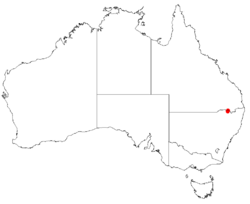Biology:Homoranthus bebo
| Homoranthus bebo | |
|---|---|

| |
| Scientific classification | |
| Kingdom: | Plantae |
| Clade: | Tracheophytes |
| Clade: | Angiosperms |
| Clade: | Eudicots |
| Clade: | Rosids |
| Order: | Myrtales |
| Family: | Myrtaceae |
| Genus: | Homoranthus |
| Species: | H. bebo
|
| Binomial name | |
| Homoranthus bebo L.M.Copel.[1]
| |

| |
| Occurrence data from AVH | |
Homoranthus bebo is a flowering plant in the family Myrtaceae and is endemic to a small area in northern New South Wales. It is a low-lying shrub with leaves that are usually flat and with groups of up to ten yellow flowers. It is only known from the Dthinna Dthinnawan Nature Reserve near Yetman.[2][3]
Description
Homoranthus bebo is a small shrub 0.05–0.2 m (2–8 in) high and 0.5–2 m (20–80 in) wide with branches lying close to the ground. The leaves are narrowly egg-shaped, shiny, lime-green, 3–7 mm (0.1–0.3 in) long, smooth, arranged in opposite pairs along a short stem with a short protruding point at the apex. The single lemon coloured five petal flowers are held erect in the leaf axils on a peduncle 0.7–1.7 mm (0.028–0.067 in) long. Flowering occurs mostly from September to November.[4]
Taxonomy and naming
Homoranthus bebo was first formally described in 2011 by Lachlan Copeland, Lyndley Craven and Jeremy Bruhl from a specimen collected in the Bebo State forest (now the Dthinna Dthinnawan Nature Reserve) in 2001 and the description was published in Australian Systematic Botany.[5] The specific epithet (bebo) refers to the name of the state forest where the type specimen was collected.[5]
Distribution and habitat
Currently known from a single population in Dthinna Dthinnawan Nature Reserve (formerly Bebo State Forest)~20 km north-north east of Yetman New South Wales. This species grows in deep sandy soils over sandstone.[4]
Conservation
Homoranthus bebo is classified as "critically endangered" under the Australian Government EPBC Act of 1999.[6][7] It is known from a single population of at least 300 individuals.[4]
References
- ↑ "Homoranthus bebo". Australian Plant Census. https://biodiversity.org.au/nsl/services/apc-format/display/236632.
- ↑ Wilson, Peter G.. "Homoranthus bebo". Royal Botanic Garden Sydney. http://plantnet.rbgsyd.nsw.gov.au/cgi-bin/NSWfl.pl?page=nswfl&lvl=sp&name=Homoranthus~bebo.
- ↑ Hunter, John (October 2016). "Mapping of Homoranthus bebo". Technical report.
- ↑ 4.0 4.1 4.2 Copeland, Lachlan M.; Craven, Lyn A.; Bruhl, Jeremy J. (2011). "A taxonomic review of Homoranthus (Myrtaceae: Chamelaucieae)". Australian Systematic Botany 24 (6): 351. doi:10.1071/SB11015.
- ↑ 5.0 5.1 "Homoranthus bebo". APNI. https://id.biodiversity.org.au/instance/apni/731247.
- ↑ "NSW Threatened Species Scientific Committee - Preliminary determination". New South Wales Government Office of Environment and Heritage. https://www.environment.nsw.gov.au/resources/threatenedspecies/determinations/PDHomobeboCR.pdf.
- ↑ "Homoranthus bebo". Australian Government Department of the Environment. https://www.environment.gov.au/system/files/consultations/75a1315e-fb15-4131-91a6-7379bfb28ab1/files/homoranthus-bebo.pdf.
External links
Wikidata ☰ Q56280649 entry
 |



